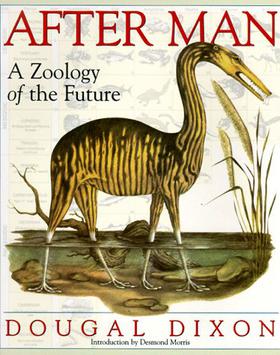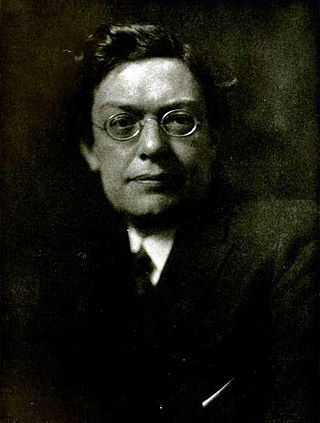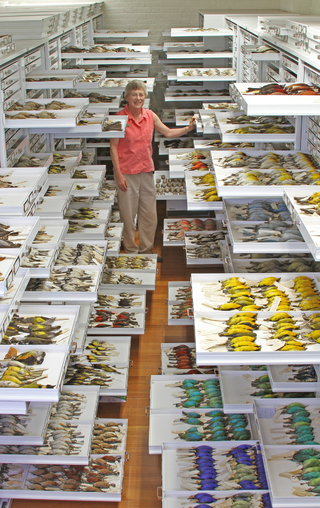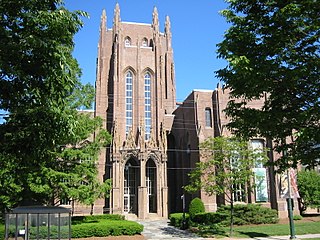
The Natural History Museum in London is a museum that exhibits a vast range of specimens from various segments of natural history. It is one of three major museums on Exhibition Road in South Kensington, the others being the Science Museum and the Victoria and Albert Museum. The Natural History Museum's main frontage, however, is on Cromwell Road.

The Royal Ontario Museum (ROM) is a museum of art, world culture and natural history in Toronto, Ontario, Canada. It is one of the largest museums in North America and the largest in Canada. It attracts more than one million visitors every year, making it the most-visited museum in Canada. It is north of Queen's Park, in the University of Toronto district, with its main entrance on Bloor Street West. Museum subway station is named after it and, since a 2008 renovation, is decorated to resemble the ROM's collection at the platform level.

The Field Museum of Natural History (FMNH), also known as The Field Museum, is a natural history museum in Chicago, Illinois, and is one of the largest such museums in the world. The museum is popular for the size and quality of its educational and scientific programs, and its extensive scientific specimen and artifact collections. The permanent exhibitions, which attract up to 2 million visitors annually, include fossils, current cultures from around the world, and interactive programming demonstrating today's urgent conservation needs. The museum is named in honor of its first major benefactor, Marshall Field, the department-store magnate. The museum and its collections originated from the 1893 World's Columbian Exposition and the artifacts displayed at the fair.

The American Museum of Natural History (AMNH) is a natural history museum on the Upper West Side of Manhattan in New York City. Located in Theodore Roosevelt Park, across the street from Central Park, the museum complex comprises 20 interconnected buildings housing 45 permanent exhibition halls, in addition to a planetarium and a library. The museum collections contain about 35 million specimens of plants, animals, fungi, fossils, minerals, rocks, meteorites, human remains, and human cultural artifacts, as well as specialized collections for frozen tissue and genomic and astrophysical data, of which only a small fraction can be displayed at any given time. The museum occupies more than 2,500,000 sq ft (232,258 m2). AMNH has a full-time scientific staff of 225, sponsors over 120 special field expeditions each year, and averages about five million visits annually.

The Canadian Museum of Nature is a national natural history museum based in Canada's National Capital Region. The museum's exhibitions and public programs are housed in the Victoria Memorial Museum Building, a 18,910-square-metre structure (203,500 sq ft) in Ottawa, Ontario. The museum's administrative offices and scientific centres are housed at a separate location, the Natural Heritage Campus, in Gatineau, Quebec.

Carl Ethan Akeley was a pioneering American taxidermist, sculptor, biologist, conservationist, inventor, and nature photographer, noted for his contributions to American museums, most notably to the Milwaukee Public Museum, Field Museum of Natural History and the American Museum of Natural History. He is considered the father of modern taxidermy. He was the founder of the AMNH Exhibitions Lab, the interdisciplinary department that fuses scientific research with immersive design.

The Florida Museum of Natural History (FLMNH) is Florida's official state-sponsored and chartered natural history museum. Its main facilities are located at 3215 Hull Road on the campus of the University of Florida in Gainesville.

The Natural History Museum of Los Angeles County is the largest natural and historical museum in the western United States. Its collections include nearly 35 million specimens and artifacts and cover 4.5 billion years of history. This large collection comprises not only of specimens for exhibition, but also vast research collections housed on and offsite.

After Man: A Zoology of the Future is a 1981 speculative evolution book written by Scottish geologist and palaeontologist Dougal Dixon and illustrated by several illustrators including Diz Wallis, John Butler, Brian McIntyre, Philip Hood, Roy Woodard and Gary Marsh. The book features a foreword by Desmond Morris. After Man explores a hypothetical future set 50 million years after extinction of humanity, a time period Dixon dubs the "Posthomic", which is inhabited by animals that have evolved from survivors of a mass extinction succeeding our own time.

The Denver Museum of Nature & Science is a municipal natural history and science museum in Denver, Colorado. It is a resource for informal science education in the Rocky Mountain region. A variety of exhibitions, programs, and activities help museum visitors learn about the natural history of Colorado, Earth, and the universe. The 716,000-square-foot (66,519 m2) building houses more than one million objects in its collections including natural history and anthropological materials, as well as archival and library resources.

Charles Robert Knight was an American wildlife and paleoartist best known for his detailed paintings of dinosaurs and other prehistoric animals. His works have been reproduced in many books and are currently on display at several major museums in the United States. One of his most famous works is a mural of Tyrannosaurus and Triceratops, which helped establish the two dinosaurs as "mortal enemies" in popular culture. Working at a time when many fossil discoveries were fragmentary and dinosaur anatomy was not well understood, many of his illustrations have later been shown to be incorrect representations. Nevertheless, he has been hailed as "one of the great popularizers of the prehistoric past".
The North Carolina Museum of Natural Sciences (NCMNS) is a museum in Raleigh, North Carolina. The museum is the oldest in the state.

The Museum of Comparative Zoology is a zoology museum located on the grounds of Harvard University in Cambridge, Massachusetts. It is one of three natural-history research museums at Harvard, whose public face is the Harvard Museum of Natural History. Harvard MCZ's collections consist of some 21 million specimens, of which several thousand are on rotating display at the public museum. In July 2021, Gonzalo Giribet, Alexander Agassiz Professor of Zoology at Harvard and Curator of Invertebrate Zoology, was announced as the new director of the museum.

The Iziko South African Museum is a South African national museum located in Cape Town. The museum was founded in 1825, the first in the country. It has been on its present site in the Company's Garden since 1897. The museum houses important African zoology, palaeontology and archaeology collections.

The Fukui Prefectural Dinosaur Museum, located in Katsuyama, Fukui, Japan, is one of the leading dinosaur museums in Asia that is renowned for its exhibits of fossil specimens of dinosaurs and paleontological research. It is sited in the Nagaoyama Park near the Kitadani Dinosaur Quarry that the Lower Cretaceous Kitadani Formation of the Tetori Group is cropped out and a large number of dinosaur remains including Fukuiraptor kitadaniensis and Fukuisaurus tetoriensis are found and excavated.
The Age of Reptiles is a 110-foot (34 m) mural depicting the period of ancient history when reptiles were the dominant creatures on the earth, painted by Rudolph Zallinger. The fresco sits in the Yale Peabody Museum in New Haven, Connecticut, and was completed in 1947 after five years of work. The Age of Reptiles was at one time the largest painting in the world, and depicts a span of nearly 350 million years in Earth's history.

The University of Iowa Museum of Natural History is a natural history museum on the University of Iowa campus in Iowa City, Iowa. The museum was founded in 1858 by instruction of the Iowa General Assembly as the Cabinet of Natural History. It is housed within Macbride Hall, located in the Pentacrest area of the university campus. The museum's collections contain around 140,000 objects, including approximately 31,000 birds, eggs, and nests, 5,000 mammal specimens, 41,000 insects, 44,000 other invertebrates, 6,000 archaeological specimens, and historical documents and images from the museum's history. The museum includes several galleries on Iowa's geological and cultural history, biological diversity, and environmental science, spanning four floors. Major research collections include the Kallam Collection of prehistoric stone tools, the Talbot and Jones Bird Collections, the Frank Russell Collection of Inuit and Native Arctic artifacts, and the Philippine Collection of ethnographic materials from the 1904 World's Fair.

A mobile museum is a museum educational outreach program that bring the museum to the people rather than vice versa. Typically they can be in Recreational Vehicles (RVs) or trucks/trailers that drive to schools, libraries and rural events. Their business model is to use grant or donor support, as they goal is to make the museum exhibit accessible to underserved populations. Below are some examples of mobile museums.

The Peabody Museum of Natural History at Yale University is one of the oldest, largest, and most prolific university natural history museums in the world. It was founded by the philanthropist George Peabody in 1866 at the behest of his nephew Othniel Charles Marsh, an early paleontologist. The museum is best known for the Great Hall of Dinosaurs, which includes a mounted juvenile Brontosaurus and the 110-foot-long (34 m) mural The Age of Reptiles. The museum also has permanent exhibits dedicated to human and mammal evolution; wildlife dioramas; Egyptian artifacts; local birds and minerals; and Native Americans of Connecticut.

James Perry Wilson was an American, painter, designer, and architect best known for his natural history dioramas. Active for over 40 years, he is noted for his work with the American Museum of Natural History, the Peabody Museum of Natural History, and the Boston Museum of Science.
























